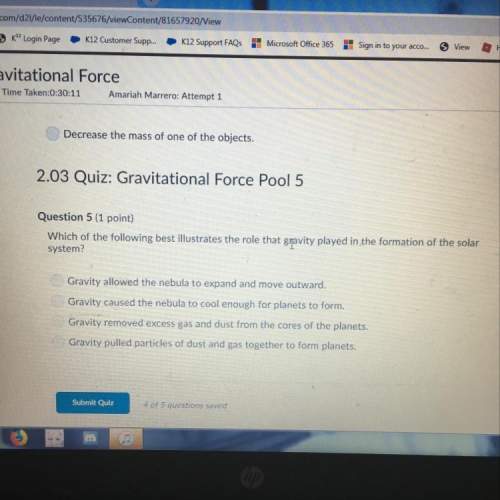
Chemistry, 06.05.2020 22:05 eaglesjohnson414
A mixture of 100 kg mol that contains 60 mol % n-pentane (A) and 40 mol % nheptane (B) is vaporized at 101.32 kPa pressure under differential conditions until 40 kg mol are distilled. Use equilibrium data from Example 26.3-2. a. What is the average composition of the total vapor distilled and the composition of the remaining liquid? b. If this same vaporization is done in an equilibrium or flash distillation and 40 kg mol are distilled, what is the composition of the vapor distilled and of the remaining liquid?

Answers: 3
Another question on Chemistry

Chemistry, 21.06.2019 20:20
Calculate the molarity of the solution. 6.02 x 1022 molecules of hci (molecular weight = 36.5 g/mole) in 2.0 liters of water m
Answers: 1

Chemistry, 21.06.2019 22:10
How do forces between particles in gases compare to forces in the other states of matter? o a. the forces in gases are stronger than forces in solids but weaker than forces in liquids. o b. the forces in gases are weaker than forces in solids but stronger than forces in liquids. o c. the forces in gases are weaker than forces in solids and liquids. o d. the forces in gases are stronger than forces in solids and liquids. submit
Answers: 1

Chemistry, 22.06.2019 06:00
Oxidation-reduction reactions (often called "redox" for short) are reactions that involve the transfer of electrons from one species to another. oxidation states, or oxidation numbers, allow chemists to keep track of these electron transfers. in general, one element will lose electrons (oxidation), with the result that it will increase in oxidation number, and another element will gain electrons (reduction), thereby decreasing in oxidation number. the species that is oxidized is called the reducing agent or reductant. the species that is reduced is called the oxidizing agent or oxidant. to sum up: oxidation = increase in oxidation state = loss of electrons = reducing agent reduction = decrease in oxidation state = gain of electrons = oxidizing agent part a which element is oxidized in this reaction? fe2o3+3co→2fe+3co2 enter the elemental symbol. view available hint(s) is oxidized part b which element is reduced in this reaction? 2hcl+2kmno4+3h2c2o4→6co2+2mno2+2kcl+4h2o enter the elemental symbol. view available hint(s) is reduced
Answers: 1

Chemistry, 22.06.2019 07:30
The scheme below is from a series of reactions that are part of a synthesis of vitamin a. answer the following questions with reference to this scheme. (i) what is "reagent a"? (ii) draw a step-by-step mechanism which explains the formation of compound c from compound b (iii) which reagents would you use to form compound e from compounds c and d (reagents b and c)? for each reagent suggested above in (ii) explain the role of the reagent in the reaction to (iv) form compound e. you may wish to do this by drawing a mechanism. 1. addition of reagent a но reagent a 2. н,о" thо oh нон-с compound a. compound b. compound c .ch-оh 1. reagent b "сно 2. reagent c сh oh compound e. compound d.
Answers: 2
You know the right answer?
A mixture of 100 kg mol that contains 60 mol % n-pentane (A) and 40 mol % nheptane (B) is vaporized...
Questions

Geography, 24.08.2019 05:20

History, 24.08.2019 05:20

Mathematics, 24.08.2019 05:20

Mathematics, 24.08.2019 05:20

Mathematics, 24.08.2019 05:20







History, 24.08.2019 05:20

Physics, 24.08.2019 05:20

Mathematics, 24.08.2019 05:20

Mathematics, 24.08.2019 05:20


Computers and Technology, 24.08.2019 05:20

Geography, 24.08.2019 05:20

History, 24.08.2019 05:20




